10 Natural Ways To Get Rid Of Strawberry Legs
Easy and effective ways to eliminate those unsightly black spots on your legs
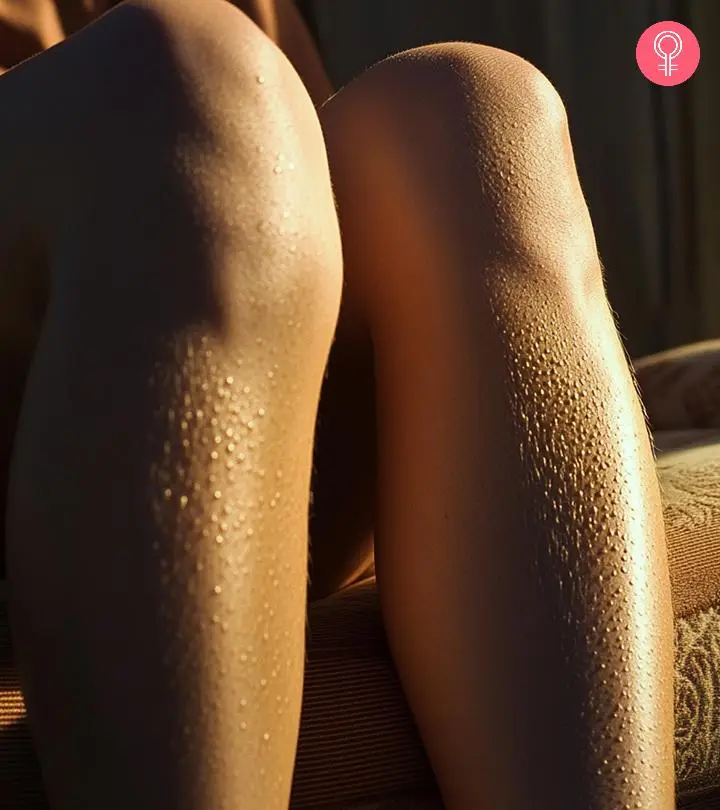
Image: Midjourney/ StyleCraze Design Team
The term strawberry legs refers to the dark spots on the legs. These dark spots look like black dots. The medical term for this condition is folliculitis. The condition can be quite embarrassing, which is why you may wonder how to get rid of strawberry legs.
The skin pores on the legs may get congested and form comedones, which appear as dark bumps/hyperpigmentation on your leg, resembling the strawberry skin and seeds.
The good news is that you can easily treat strawberry legs at home and prevent the condition. This article explores the underlying reasons for this condition and various home remedies and professional treatments available. Keep reading to learn more.
In This Article
What Are Strawberry Legs?
Strawberry legs are nothing but the presence of small black dots just beneath the upper layer of the skin, caused by inflamed hair follicles. This gives your legs a strawberry-like appearance, hence the name.
These pores, also called open comedones, are hair follicles or ingrown hairsi A condition in which hair that has been shaved or plucked curves into the skin when growing back, causing inflammation. that are trapped under the skin. They may also contain a mixture of bacteria, dead skin cells, and oil.
They are not harmful in any way but can make you feel self-conscious.
Strawberry legs are not usually a cause for concern. Dr. Anna Chacon, a board-certified dermatologist, says, “Strawberry legs go away in time. These appear on your skin simply because of inflamed follicles due to shaving.”
Strawberry legs look similar in most people, but the causes may be different for each person.
Key Takeaways
- The causes of strawberry legs differ from person to person. While excessive keratin production is to be blamed in some, inflamed hair follicles or dry skin can also lead to dark spots on the legs.
- This skin condition is benigni Refers to a skin condition that does not have the potential to influence or affect the body in harmful ways. and can be treated with simple kitchen ingredients, such as lemon, brown sugar, and baking soda.
- Exfoliating and moisturizing the skin will help you achieve softer legs.
What Causes Strawberry Legs?
Here are some common causes of strawberry legs:
- Keratosis pilaris – This is also known as chicken skin and occurs when your skin produces excessive keratin, which blocks the hair follicles. This leads to tiny bumps and patchy skin.
- Dry Skin – If your skin is not well moisturized, it becomes dry and rough. This makes your epidermis vulnerable to irritation caused by shaving.
- Folliculitis – This is a condition in which your hair follicles are inflamed. It might happen due to bacteria or fungi. Folliculitis results from ingrown hairs from improper shaving techniques. Using a blunt razor or shaving without enough lubrication can irritate the hair follicles.
If you have strawberry legs, you are most likely experiencing one or more of the following symptoms.
What Are The Symptoms Of Strawberry Legs?
- Strawberry-like appearance of your legs
- Small reddish or blackish bumps or dark spots on the legs
- Clogged pores on the skin
- Rough, dry, and irritated skin
If the reason behind your strawberry legs is keratosis pilaris, you try home remedies for keratosis pilaris to manage the condition and smoothen your legs. Otherwise, you may also try these home remedies that will resolve the query about how to get rid of strawberry legs.
Home Treatment For Strawberry Legs
1. Baking Soda
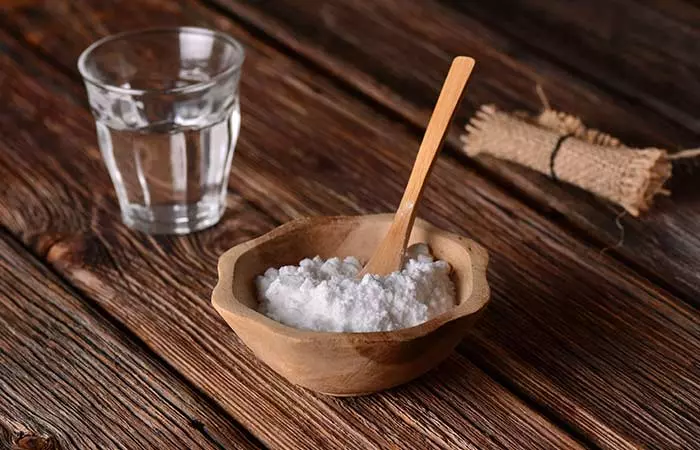
Baking soda works as an anti-inflammatory and antibacterial agent.
A 1997 study published in Compendium of Continuing Education in Dentistry examined the antibacterial effects of baking soda. Researchers tested its ability to kill Streptococcus mutans, a bacteria linked to tooth decay, using different methods. They found that baking soda significantly inhibited bacterial growth, and its effect was even stronger when combined with a detergent (sodium dodecyl sulfate). The study suggests that using oral care products with high baking soda concentrations may help lower cavity-causing bacteria in saliva and plaque (1). It exfoliates your skin and makes it smooth and radiant. It is also known to prevent and treat severe dryness of the skin (2).
You Will Need
- 1 tablespoon of baking soda
- 1 teaspoon of water
What You Need To Do
- Make a paste by mixing the baking soda and water.
- Apply this mixture to the affected area on your legs and let it dry for 4 to 5 minutes.
- Rinse with cold water.
How Often You Should Do This
You can try this remedy every day.
2. Exfoliation
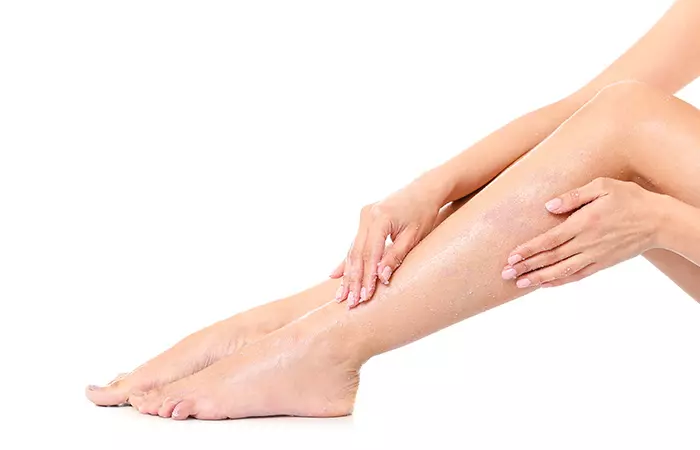
Exfoliation of skin helps remove dead cells from the top layer of the skin and gets rid of any bacteria that might be present. It also eliminates the chances of ingrown hair.
You Will Need
- ½ cup of brown sugar
- ½ cup of almond or olive oil
- 3-4 drops of clove oil
What You Need To Do
- Mix all the ingredients to make a paste.
- Apply the paste to the legs and rub in circles for a few minutes to exfoliate the skin.
- Rinse with cold water.
How Often You Should Do This
You can exfoliate your legs 1-2 times a week until you start noticing a difference in your legs.
 Quick Tip
Quick Tip3. Aloe Vera
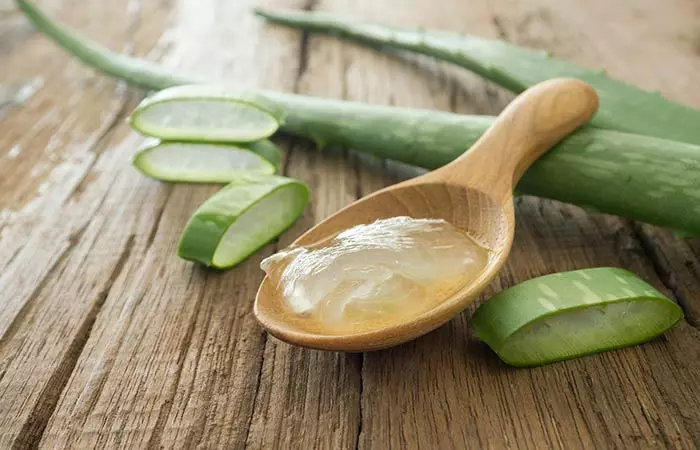
Aloe vera is a very powerful moisturizer and has excellent skin healing properties. A 2016 animal study published in the Annals Of Plastic Surgery journal found that topical aloe vera gel significantly improved wound healing and improved scar tissue structure. Higher doses led to stronger, more elastic tissue with increased collagen and glycosaminoglycans, essential for skin repair. The study suggests that Aloe vera could be a beneficial treatment for wound healing in clinical practice (3). Applying it every day will always keep the skin hydrated and enhance its beauty and plumness. That’s why aloe vera is quite popular in commercial skin products as well as in dermatology.
You Will Need
1 leaf of fresh aloe vera
What You Need To Do
- Extract the gel from a fresh aloe vera leaf.
- Apply this gel on your legs and massage gently for a minute or two.
- Leave it on for about 10 minutes.
- Rinse with cold water.
How Often You Should Do This
Apply aloe vera gel on your legs every day.
4. Sea Salt
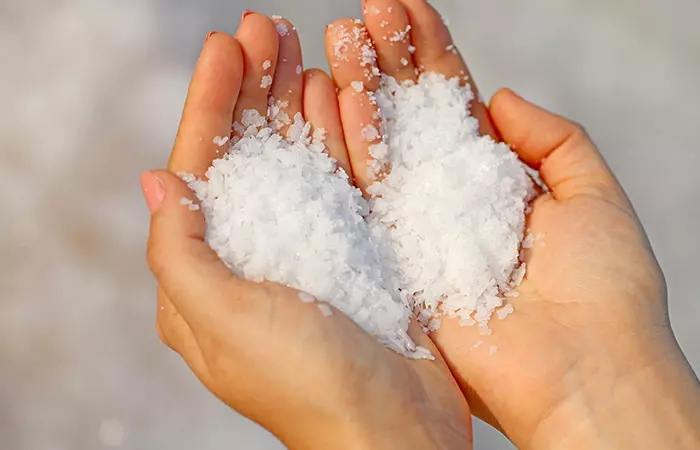
Sea salt is packed with minerals like calcium, sodium, magnesium, and potassium (4). These minerals play a major role in our skin’s health and pH balance. When the mineral balance of the body is disturbed, our skin shows symptoms, such as dryness, itchiness, and irritation. Applying a sea salt scrub on the body removes dead cells from the skin’s surface and restores mineral balance in the body.
You Will Need
- ¼ cup of sea salt
- ½ cup of coconut oil
- A washcloth (optional)
What You Need To Do
- Mix the sea salt and coconut oil to form a thick paste.
- Using a washcloth or your palms, scrub this mixture gently on your legs.
- Continue for a minute or two and then rinse with water.
How Often You Should Do This
As sea salt can be abrasive on the skin, don’t use this scrub every day. Use it 1-2 times a week to notice results in a month’s time.
5. Ground Coffee
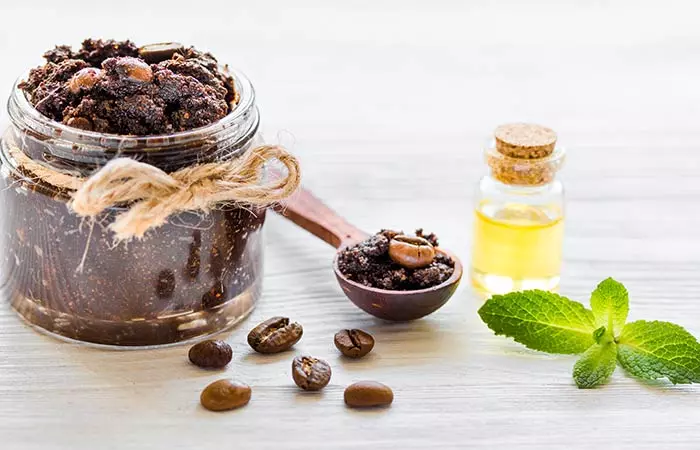
Ground coffee works as a great exfoliator for the skin. When mixed with olive or coconut oil, it helps in sloughing dead cells and leaves the skin smooth and radiant.
You Will Need
- ½ cup of ground coffee
- ½ cup of palm sugar
- ¼ cup of coconut oil
What You Need To Do
- Make sure all the ingredients are at room temperature.
- Mix them in a bowl to form a scrub.
- Apply on the legs in a circular motion and rinse off with water.
How Often You Should Do This
You can use this scrub to exfoliate your legs 1-2 times a week. More than twice a week may over exfoliate the skin, causing irritation.
6. Tea Tree And Jojoba Oil
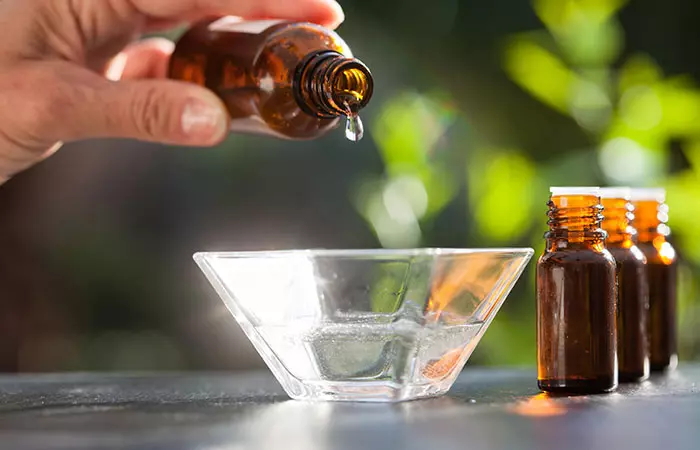
Both tea tree oil and jojoba oils have antimicrobial and anti-inflammatory properties and can treat dry, dead skin (5). A 2013 review published in the Giornale Italiano Di Dermatologia E Venereologia journal highlighted the dermatological benefits of jojoba. Jojoba oil, rich in wax esters, has anti-inflammatory properties and has been used for treating skin infections, aging, and wound healing. It is also commonly included in cosmetic formulations like sunscreens and moisturizers and enhances the absorption of topical medications. The review suggests that jojoba’s unique composition makes it a valuable ingredient in dermatology and skincare applications (6). These oils can speed up wound healing and treat skin issues like dryness and itching and prevent clogged pores.
You Will Need
- 2-3 drops of tea tree oil
- 1 tablespoon of jojoba oil
What You Need To Do
- Mix the tea tree oil and jojoba oils.
- Massage this mixture onto your legs. Let your skin absorb this for 5-10 minutes. Rinse with water.
How Often You Should Do This
You can use this remedy every night before bedtime.
7. Buttermilk Bath

Buttermilk contains lactic acid, which is a natural chemical exfoliant. It can leave your skin brighter and smoother.
You Will Need
- 1 cup of buttermilk
- A bucketful of water
What You Need To Do
- Run a bath and add a cup of buttermilk to your bathwater.
- Soak yourself in this buttermilk and water mixture for a few minutes.
- Shower as usual.
How Often You Should Do This
You can do this every day to keep your skin radiant and avoid clogged pores.
8. Moisturize

Keeping your skin well moisturized at all times prevents dryness and skin irritation. Shaving over irritated skin results in strawberry legs.
You Will Need
A good moisturizer
What You Need To Do
- Pour some moisturizer on your palms.
- Rub your hands together and spread the moisturizer evenly throughout your body.
How Often You Should Do This
You should moisturize your body as often as you can – every day after a shower.
 Quick Tip
Quick Tip9. Rose Water and Cucumber
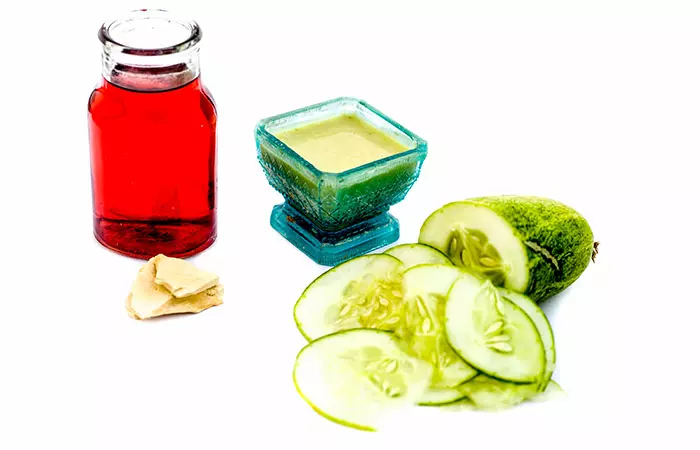
Cucumber is rich in Vitamin C, which prevents skin irritation. It also has calming and anti-inflammatory properties (7).
Rose water is known to calm the skin and open clogged pores (8).
You Will Need
- 1 cucumber
- A few drops of rose water
What You Need To Do
- Blend the cucumber until it is juiced.
- Add a few drops of rose water to the cucumber juice and mix well.
- Apply this mixture to your legs and let it dry for about 10 to 15 minutes.
- Rinse with water.
How Often You Should Do This
You can do this every day. Repeat it until you start seeing visible results on your legs.
10. Egg Whites And Lemon Juice
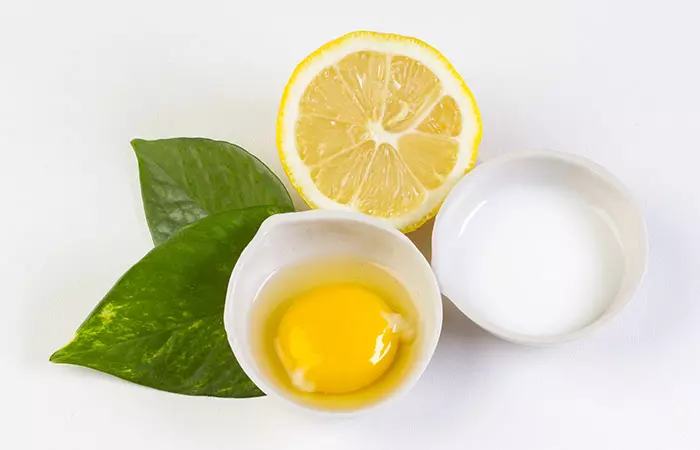
Egg whites tighten and brighten the skin. They contain a plethora of nutrients – proteins, vitamins, and minerals that nourish our skin. Egg whites are also powerful astringents that can clean and reduce pores (9). Lemon juice is a natural bleaching agent (10).
You Will Need
- 1 egg white
- 1 teaspoon of lemon juice
What You Need To Do
- Mix the egg white and the lemon juice.
- Using a brush (or your fingers), apply this mixture on your legs.
- Leave it on for 5-10 minutes and rinse with water.
How Often You Should Do This
You can do this once every day, preferably before your shower.
Sometimes, people may also develop strawberry legs due to improper shaving and razor bumps. Thus learning how to get rid of razor bumps may also help you prevent the bumps and spots.
If home remedies do not work for you or if you want a more permanent solution for your strawberry legs, consult a dermatologist. They might recommend an active ingredient like glycolic acid to treat this issue. Scroll down to the next section to find out.
Glycolic Acid For Strawberry Legs
A study published in the World Journal of Clinical Cases found that a high concentration of glycolic acid may help improve skin roughness and follicular hyperpigmentation in patients with keratosis pilaris. The study further observed that the treatment is safe and shows quick results (11). However, a 5-year follow-up with the treated individuals showed that the effects were not long-term. While glycolic acid may help with strawberry legs, you may need to use this active ingredient regularly to reap its benefits. You may use a lotion or serum containing glycolic acid or one given by your dermatologist.
Your dermatologist may also suggest laser hair removal. Here is what you need to know about it.
Medical Professional Treatment: Laser Hair Removal
Laser hair removal uses concentrated light to destroy hair follicles beneath your skin surface. It usually takes about 4 to 6 sittings to get rid of all your hair permanently.
Some people might experience some hair growing back at a later stage, which can be taken care of by another session of laser treatment.
This treatment is perfectly safe and is used by several people across the globe. However, it is always best to prevent it rather than treat it. So, here are a few tips.
Prevention Tips For Strawberry Legs
To prevent the occurrence of strawberry legs, you may:
- Use a sharp razor and shave in the direction of hair growth.
- Use a clean razor and shaving cream to avoid irritation and ingrown hairs.
- Exfoliate regularly to remove dead skin cells and prevent clogged pores.
- Moisturize daily to keep your skin hydrated and reduce irritation
- Gently scrub your skin to remove dead cells and prevent ingrown hairs.
- Opt for breathable fabrics to minimize friction and irritation on your legs.
- Explore options like waxing or laser hair removal to reduce skin irritation.
The key is to keep your skin healthy and free of irritations. Here are a few tips for making your legs soft.
Tips To Get Soft Legs Naturally
- Drink plenty of water every day.
- Scrub your body and exfoliate dead cells at least 1-2 times a week.
- Moisturize your skin immediately after a shower. You can also moisturize at night before bed. Always use a good quality moisturizer.
- Use sunscreen to prevent the harmful UV rays from damaging your skin. Always apply sunscreen at least 15 to 20 minutes before you step out.
- Use safe hair removal methods, like waxing or epilatingi A type of hair removal process that involves using an electrical device to pull the hair from its roots. . These methods remove the hair from the root and prevent any possibility of ingrown hair.
- Eat healthy to give your body the nourishment it deserves.
- Get frequent body massages done to get your circulation going.
”Waxing does not stop but prevents strawberry legs as each hair is removed from the root,” says Dr. Anna Chacon, a board-certified dermatologist.
Infographic: Tips To Prevent The Risk Of Strawberry Legs While Shaving
Improper shaving and lack of proper skin care may aggravate strawberry legs. While there isn’t a quick fix for this condition, minor adjustments to your skin care routine and a few precautions while shaving your legs can help. Check the infographic below for some effective tips. Illustration: StyleCraze Design Team
Strawberry legs are characterized by small dark spots on the legs. Dry skin, folliculitis, and keratosis pilaris are the common causes of this condition. However, certain natural remedies for strawberry legs can help. These include using baking soda, exfoliating the skin, applying aloe vera, and scrubbing with sea salt and ground coffee beans. In addition, moisturizing the skin immediately after the shower, drinking plenty of water, and scrubbing your body may help prevent dark spots on your legs. However, if these natural strawberry legs treatments do not work, consult your dermatologist.
Frequently Asked Questions
Does chemical peel remove strawberry legs?
Yes, a chemical peel is commonly prescribed for exfoliating dead skin cells and dealing with strawberry legs.
Can I use coconut oil for strawberry legs?
Strawberry legs can benefit from moisturization and coconut oil can be used for that purpose. It can also be used as a moisturizer before shaving as a preventive measure against strawberry legs.
Does dry brushing help strawberry legs?
Anecdotal evidence suggests that a dry brushing may help treat strawberry legs as it exfoliates clogged-up skin. However, it must be done carefully if you have sensitive skin as it may lead to skin irritation.
How long does it take to fix strawberry legs?
You can fix strawberry legs within a few weeks if you follow adequate skin care practices like regular exfoliation and moisturization and use proper hair removal methods. That said, if your strawberry legs are due to genetic conditions, like keratosis pilaris, they cannot be completely healed.
Does benzoyl peroxide get rid of strawberry legs?
Yes, benzoyl peroxide may help you get rid of strawberry legs if they are caused due to folliculitis, a mild form of acne. However, more research is needed to support this claim.
Does retinol help strawberry legs?
Research shows that topical retinoids may help treat keratosis pilaris (12). A topical retinoid called tazarotene (0.01% concentration), when applied regularly at night, faded keratosis pilaris within 2 weeks. By 4-8 weeks the issue was completely resolved.
Can strawberry legs be permanent or long-lasting?
No, strawberry legs are not permanent or long-lasting and can go away in time with the correct treatment and regular skin care practices. However, you may experience permanent strawberry legs if you have genetic skin disorders like folliculitis and keratosis pilaris.
Are you tired of razor bumps and strawberry skin? Watch this step-by-step video guide to achieve flawlessly smooth legs and say goodbye to skin irritation and hello to confidence!
References
Articles on StyleCraze are backed by verified information from peer-reviewed and academic research papers, reputed organizations, research institutions, and medical associations to ensure accuracy and relevance. Read our editorial policy to learn more.
- Antibacterial activity of baking soda. Compendium of Continuing Education in Dentistry. Supplement, US National Library of Medicine, National Institutes of Health.
https://pubmed.ncbi.nlm.nih.gov/12017929/ - Ichthyosis with confetti: a rare diagnosis and treatment plan. BMJ Case Reports, US National Library of Medicine, National Institutes of Health.
https://www.ncbi.nlm.nih.gov/pmc/articles/PMC4112313/ - Topical Application of Aloe vera Accelerated Wound Healing, Modeling, and Remodeling: An Experimental Study. Annals of Plastic Surgery, US National Library of Medicine, National Institutes of Health.
https://pubmed.ncbi.nlm.nih.gov/25003428/ - Natural sea salt consumption confers protection against hypertension and kidney damage in Dahl salt-sensitive rats, Food & Nutrition Research, US National Library of Medicine, National Institutes of Health.
https://www.ncbi.nlm.nih.gov/pmc/articles/PMC5328355/ - A review of applications of tea tree oil in dermatology. International Journal of Dermatology, US National Library of Medicine, National Institutes of Health.
https://pubmed.ncbi.nlm.nih.gov/22998411/ - Jojoba in dermatology: a succinct review. Giornale italiano di dermatologia e venereologia, US National Library of Medicine, National Institutes of Health.
https://pubmed.ncbi.nlm.nih.gov/24442052/ - Phytochemical and therapeutic potential of cucumber. Fitoterapia, US National Library of Medicine, National Institutes of Health.
https://pubmed.ncbi.nlm.nih.gov/23098877/ - Pre-Feasibility Study: Rose Water. Small and Medium Enterprise Development Authority, Government of Pakistan.
http://www.amis.pk/files/PrefeasibilityStudies/SMEDA%20Rose%20Water.pdf - DIY Skincare Straight From Your Kitchen. OGLE School.
https://www.ogleschool.edu/blog/diy-skincare-straight-kitchen/ - The Hunt for Natural Skin Whitening Agents. International Journal of Molecular Sciences, US National Library of Medicine, National Institutes of Health.
https://www.ncbi.nlm.nih.gov/pmc/articles/PMC2801997/ - Clinical outcomes and 5-year follow-up results of keratosis pilaris treated by a high concentration of glycolic acid, World Journal of Clinical Cases, US National Library of Medicine, National Institutes of Health.
https://www.ncbi.nlm.nih.gov/pmc/articles/PMC8223817/ - Keratosis Pilaris, StatPearls, US National Library of Medicine, National Institutes of Health.
https://www.ncbi.nlm.nih.gov/books/NBK546708/
Read full bio of Dr. Schwarzburg
- Dr. Anna Chacon, MD, FAAD, is a double board-certified dermatologist with over 7 years of experience. She has authored many peer-reviewed articles and managed clinical research studies during her fellowship. She completed her medical school in the PLME (Program of Liberal Medical Education) at Brown University.
 Dr. Anna Chacon, MD, FAAD, is a double board-certified dermatologist with over 7 years of experience. She has authored many peer-reviewed articles and managed clinical research studies during her fellowship. She completed her medical school in the PLME (Program of Liberal Medical Education) at Brown University.
Dr. Anna Chacon, MD, FAAD, is a double board-certified dermatologist with over 7 years of experience. She has authored many peer-reviewed articles and managed clinical research studies during her fellowship. She completed her medical school in the PLME (Program of Liberal Medical Education) at Brown University.
Read full bio of Shaheen Naser
Read full bio of Anjali Sayee
Read full bio of Monomita Chakraborty










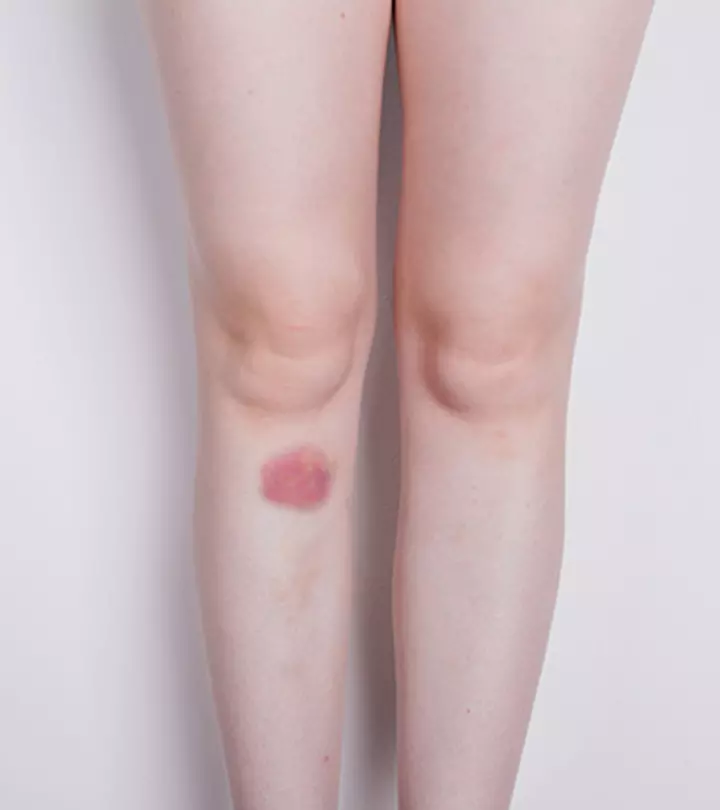

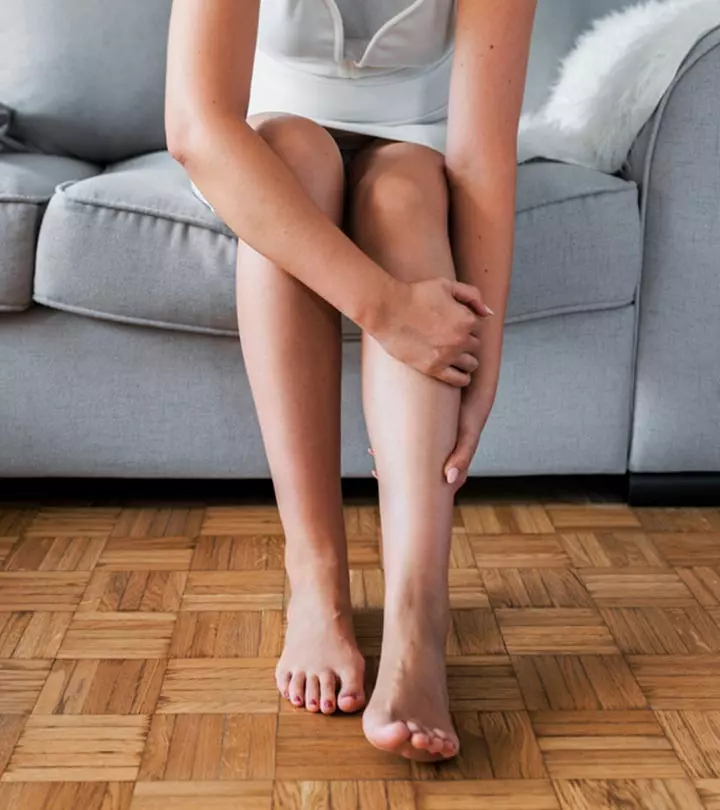
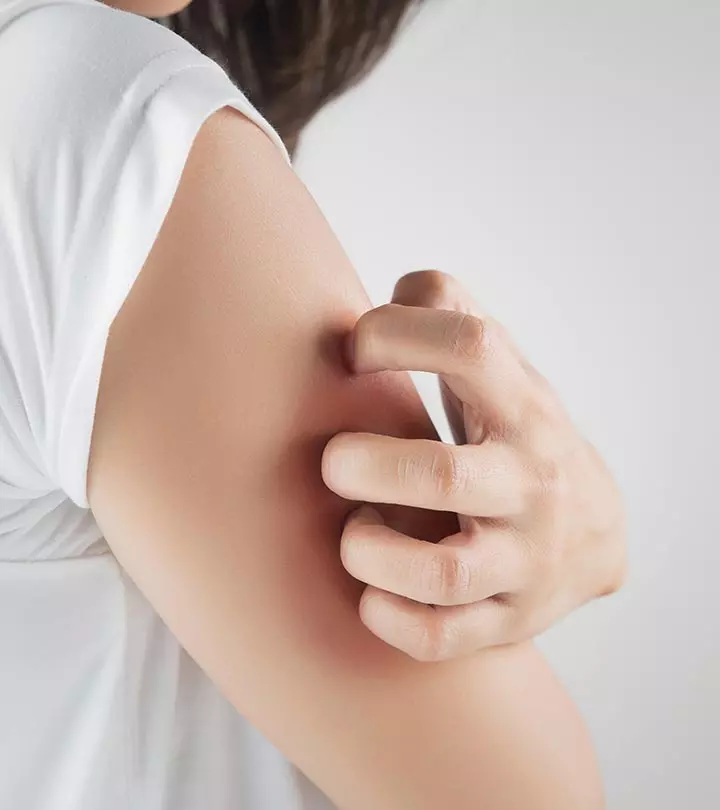
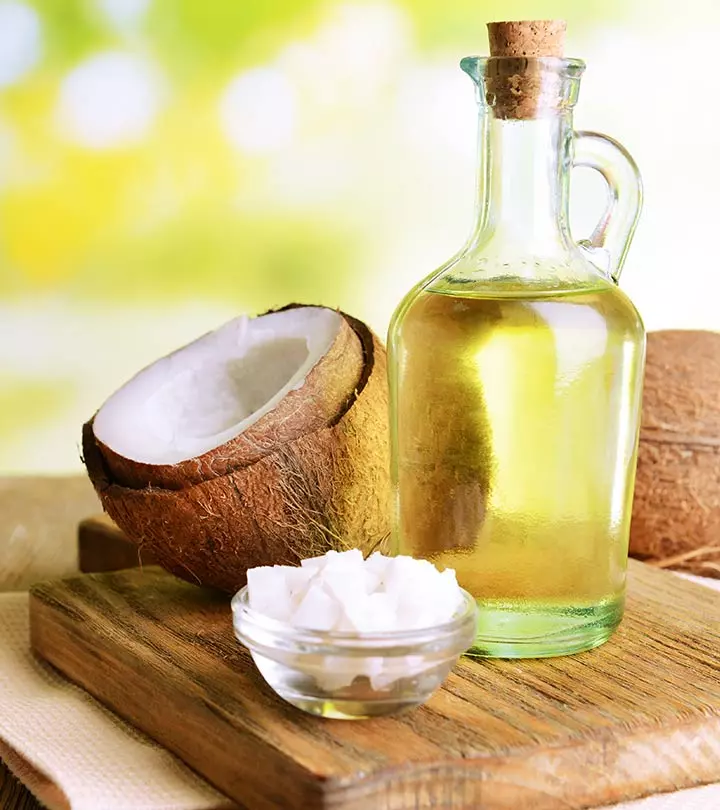



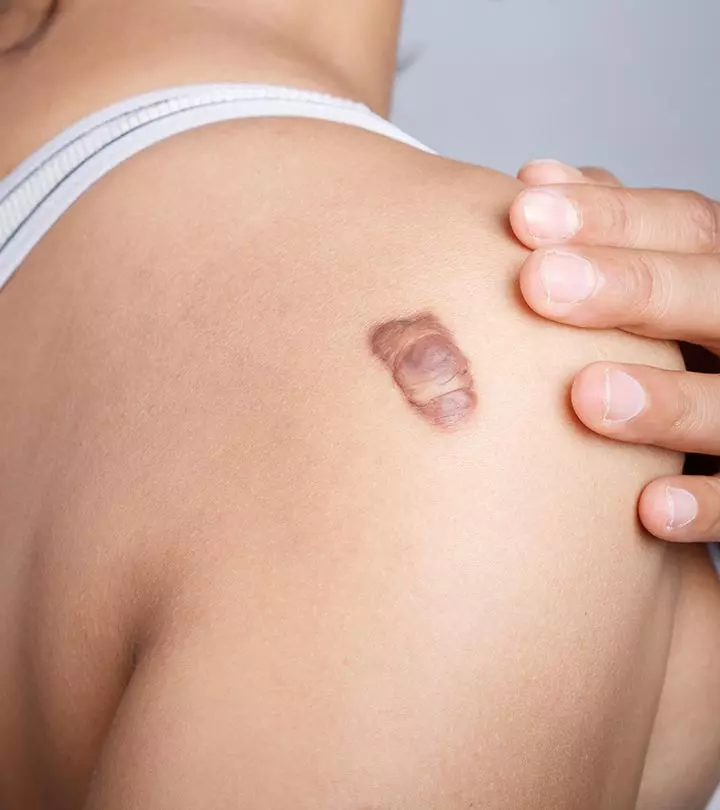









Community Experiences
Join the conversation and become a part of our empowering community! Share your stories, experiences, and insights to connect with other beauty, lifestyle, and health enthusiasts.